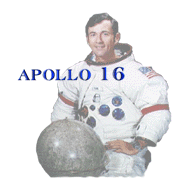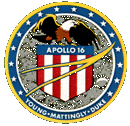
|

|
This page last updated |

|

|
This page last updated |

|
Apollo 16
AS-511
|
| 1 | 2 | 3 | 4 | 5 | 6 | 7 | 8 | 9 | 10 | 11 | 12 | 13 | 14 | |
| 15 | 16 | 17 | 18 | 19 | 20 | 21 | 22 | 23 | 24 | 25 | 26 | 27 | 28 | |
| 29 | 30 | 31 | 32 | 33 | 34 | 35 | 36 | 37 | 38 | 39 | 40 | 41 | 42 | Links |

Apollo 16 Event timeline revealed
NASA Manned Spacecraft Center Roundup - November 5, 1971Apollo 16 Astronauts John W. Young, Thomas K. Mattingly II, and Charles M. Duke are set for liftoff from Kennedy Space Center at 12 03 p.m. CST March 17, 1972, with the objective of increasing man's knowledge of his solar system by studying the evolutionary records preserved on the Moon. Such records on Earth were long ago destroyed by natural events.
The astronauts are tentatively scheduled to begin the first of their three scientific expeditions on the Moon at about 8:18 p.m. CST, March 21, four hours after touching down at the Descartes landing site.
Exploration of the Descartes area will complement data gathered from earlier Apollo missions by sampling from two distinctive lunar formations, by placing another scientific experiment station on the lunar surface, and by conducting a series of experiements from lunar orbit and during translunar and transearth flight. This will be the fifth U.S. manned lunar landing.
The second and third lunar surface expeditions are tentatively planned to begin at about 6:48 p.m. and 6:13 p.m. CST on March 22 and 23, respectively. Astronauts Young and Duke will ride the lunar roving vehicle on all three of the seven-hour trips. The lunar module is scheduled for lunar liftoff at 5:35 p.m. CST, March 24, after 73 hours on the Moon.
Scientific experiments in the Apollo command-service modules will be operated by Astronaut Mattingly during much of the 147 and one-half hours of lunar orbital flight.
Mattingly will maneuver outside the Apollo spacecraft to retrieve films from the service module experiment bay at about 3:33 p.m. CST, March 27, some 20 hours after beginning the return flight to Earth.
The planned splashdown point is about 9° South Latitude and 169.5° West Longitude in the Pacific Ocean at 3:14 p.m. CST, March 29. Total mission duration is 291 hours and 11 minutes.
The Descartes landing site is about 9 degrees south and 15.5 degrees east of the center of the Moon as viewed from Earth.
Spacecraft Commander is Navy Captain Young, who completed two Gemini and the Apollo 10 missions prior to this assignment. Command Module Pilot is Lieutenant Commander Mattingly and Lunar Module Pilot is Air Force Lieutenant Colonel Duke. Neither Mattingly nor Duke have flown in space before.
|
|
| 1 | 2 | 3 | 4 | 5 | 6 | 7 | 8 | 9 | 10 | 11 | 12 | 13 | 14 | 15 | 16 | 17 | 18 | 19 | 20 | 21 | |
| 22 | 23 | 24 | 25 | 26 | 27 | 28 | 29 | 30 | 31 | 32 | 33 | 34 | 35 | 36 | 37 | 38 | 39 | 40 | 41 | 42 | Links |
Home Biography Missions Appearances Bibliography Site Map Critique this site! Other Astros
John W. Young - American & International Hero Title Page
Page created by Dana Holland - webmaster @ johnwyoung.org
Dana's PageThis site is for informational and educational purposes only. It is NOT sanctioned by John Young, NASA, or Navarro College.